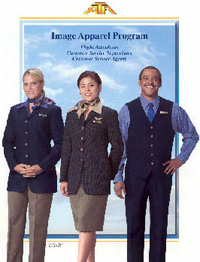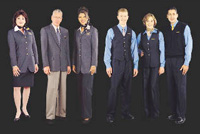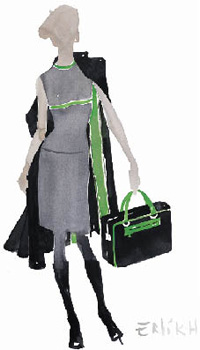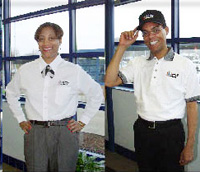|
By Brian Ness
On Dec. 17, 1903, Orville and Wilbur Wright stretched a little white muslin cloth over a spruce wood skeleton of a plane. As Wilbur watched, Orville cranked up a homemade 12 horsepower gasoline engine and left the ground on Kill Devil Hill in Kitty Hawk, N.C. for 12 seconds. It was the worlds first powered flight, traveling about 31 miles per hour. Three more airborne hops followed, the longest one covering 852 feet in 59 seconds.
100 years later, the Wright brothers invention has spawned a $107 billion industry. 612 million passengers flew in 2002, and 83% arrived on time. It is not only the fastest way to travel but also the safest. On average, a person could fly daily for about 900 years on an American commercial airliner before having an accident.
At the same time, the airlines lost more than $10 billion and cut more than 100,000 jobs in 2002. The economy has wobbled for four straight years. This and other known factors, such as security fears, have caused individual business travelers the airlines most profitable customer to dwindle. Customers have become so dissatisfied with service that more than 50% feel no loyalty toward any airline. Jet fuel prices have skyrocketed. Labor relations have crumbled. The legacy airlines are nearing or fighting bankruptcy.
Long before the airplane was invented, Charles Darwin wrote that it is not the strongest or most intelligent species that survive. It is the ones most responsive to change. For the airline industry, this theory may mean that the companies that survive will be the ones that most successfully adapt to the current environment.
Made To Measure looks at two airlines and an airport parking lot operation to see how the uniform plays a role in these changing times. ATA started after the 1978 deregulation of the industry and has grown into the 10th largest airline. Song is the new brand of the legacy carrier Delta. Lambert-St. Louis International Airport hired Super Park as part of its airport expansion program.
|

|
|
| |
|
ATA: Crisp, Clean
and Professional
In 1973, George Mikelsons purchased his first Boeing 720 and started Ambassadair Travel Club, which began with 100 travel club members. Back then, Mikelsons wore many hats: he flew the aircraft, loaded the luggage, coordinated and escorted the tour packages, and even cleaned the plane. From this one plane, he created what is now the fastest-growing carrier in the United States.
Today, ATA operates a fleet of 81 aircraft to more than 400 destinations annually, and this service is increasing steadily. Moreover, the company is often named among those companies changing the way people think of an airline.
As challenging as the times are, this is still a most exciting time to be in the aviation business, for permanent, irreversible change in our industry is surely in the air, Mikelsons says.
ATA unveiled a new uniform on Oct. 1, 2002, as a company-wide effort to update ATAs brand. ATA has been originally known as a leisure and charter airline, but it had built its business customer base through the years. Through a new branding initiative, ATA set out to create an image that more closely matched this reality. Uniforms played an important role.
Diane Suker, Director of Customer Service, first became involved with the uniform program two years before it debuted. Suker says, We wanted a new, crisp, clean, professional look for our employees, not quite as casual [as previous uniforms]. We have a new logo, new colors on board our new aircraft, and we wanted the new uniform to complement it.
During the design process, employees from all divisions of the company were placed into focus groups to review the selections and provide feedback. From this input, a final group of uniform selections was chosen that met approval from executives in both the marketing and in-flight operations departments. Mikelsons gave final approval.
Selections were chosen based on overall look, compatibility with the ATA brand, durability, practicality and comfort. The color palate of black, navy, slate blue, French blue, periwinkle, sand, taupe and pink helps customers relax. The business professional look of blazers, blouses and shirts, scarves and ties, dresses, skirts, sweaters, pants and slacks, aprons and coats remind passengers whos taking care of them. ATA has rather extensive uniform standards regarding which garments may be worn together.
When the new uniforms were introduced, an entire fitting line was sent to every area of the company, so employees could try on each of the pieces and fill out an order form. Garments are delivered directly from uniform provider Lion Apparels distribution center to each employees home. Cleaning is the responsibility of the employee, with work-related repairs being the responsibility of ATA (provided it is the result of normal use and not due to employee irresponsibility). ATA-approved tailors located in cities where employees are based make alterations.
Flight attendants are provided one blazer, two bottoms, one apron, one coat, four blouses or dress shirts and one belt. Customer service agents are provided two vests, four tops, two bottoms, and two scarves or ties. At the beginning of each year, employees are given enough credits with Lion Apparel to buy an entire set of uniform pieces. They may order online or by phone. It is up to the employee to decide which pieces to purchase. Employees are ultimately responsible for ensuring their uniforms fit well and make the best professional impression possible.
That is one of the biggest successes of the program, says Suker. Previously, our employees had to order from an internal uniform shop with limited hours of operation, which doesnt always work for flight attendants on the road. With Lion, our employees can order online any time of the day or night.
ATA continually strives for excellence in its uniform program. It monitors employee satisfaction through surveys, personal comments and sales data of each uniform piece. If a garment isnt selling as well as predicted, ATA will change it for the good of the program.
The company seizes any opportunity for improvement. In October 2003, it replaced the cardigan sweaters for ones with a tighter weave. The new cardigans feel more substantial and offer better durability through less snagging and pilling. A recent survey revealed that employees prefer the new cardigan to the previous one, too.
Another garment being improved is the womens double-pleated slacks. Employees prefer the slacks to start at the hips instead of the stomach and offer a tighter fit than the current slacks. Women also asked for flat-front slacks. Lion Apparel is developing new designs for ATA with these requests in mind. If all goes well, employees will be wearing the flat-front slacks in the second quarter of 2004. Either single-pleated or redesigned double-pleated slacks will replace the current pleated slacks in the third quarter.
Both employees and customers have had a positive response to the program. Suker says, It was just absolutely heartwarming to walk around the airport terminals and see our employees in their new look and their new uniforms. It was just like a booster shot for everyone. They got so many positive comments from each other, from our customers, and even other airline employees commented on how great the uniforms looked.
|


|
|
| |
|
Song:
Designed by Kate Spade
Delta Air Lines launched Song in April of 2003 to compete with low-cost carriers like ATA. It is already filling 70% of its seats and has grown to 142 flights daily, employing over 800 flight attendants and customer service representatives. Song provides non-stop service primarily between the Northeast and the most popular domestic leisure markets in Florida, the Caribbean and the West. In its first year, Song should generate well over $1 billion in sales, accounting for approximately 10% of Deltas 2003 revenue.
Although Song provides air service at a lower cost, Chief Executive John Selvaggio seeks to stop the consumer trend of choosing an airline based on the lowest fare over the best service or value. Like any new brand, Song makes decisions that will set itself apart from its competition, hoping to win the loyalty of its target market.
While most airlines market to business travelers, Songs consumer research revealed that women make 90% of the vacation travel plans and 75% of the purchase decisions. Songs target market is professional women, age 34-56, with a family. To reach this market, it chose a designer for its uniform program that many in this group recognize and admire: Kate Spade.
Kate Spade LLC has grown into a fashion empire, with annual sales of $70 million. Renowned for its bag and shoe collections, the company also produces other accessories associated with travel, such as luggage, baby bags, raincoats and sunglasses. With this in mind, creating uniforms was a comfortable stretch.
While other brand name designers such as Ralph Lauren and Bill Blass have been hired to design uniforms for the larger airlines, Spade is the first to partner with a low-fare carrier. We are thrilled that Kate is bringing her classic American style to the Song uniforms. We couldnt have picked a better partner than Kate Spade to introduce a sense of style to our air travel experience, said Selvaggio.
Song wants heads to turn when its flight attendants walk down the concourse, and these uniforms attract a lot of attention. The first thing passengers will notice is the vibrant green colors: parrot green (a favorite color of Spades) accenting the dress and accessories of the female flight attendant, and stripes of citrus green and parrot green streaking across the male flight attendants knit shirt. The rest of the uniform program is grounded in charcoal gray, tan, black and white.
The style is very reminiscent of the mod 60s, one of the biggest influences on the forefront of todays fashion trends. The look is a flash-back to the last time airline uniforms were considered chic. This is what Spade intended. The designs for Song look back to the glamour days of air travel, a time when both the flight staff and travelers often showed up on the tarmac with incredible style. I am happy to work with Song to bring an easy sense of sophistication and polish back to air travel, says Spade.
Women have the option of slacks or skirts and can choose their footwear from Spades high-heel pumps, low-heel Mary Janes and flats. Men are provided tan wool trousers slightly flared with a flat front and white slip-on loafers. The mens uniform is part of the Jack Spade line created by Spades husband, Andy Spade. Both mens and womens uniforms include trench coats, luggage and sunglasses.
The biggest challenge to creating a uniform program that captures what is currently in vogue is maintaining a sense of style as fashion trends continually change. Too many changes can drive up costs, while too few can make the uniform look dated. Songs program just debuted, so time will tell how well it plays the style game. It is off to a great start.
|
 |
|
| |
|
Super Park: Distinct,
Sharp and Protective
Another company off to a great start is Super Park. Opening to the public even more recently than Song (October 2003), Super Park provides all the parking and shuttle services for Lambert-St. Louis International Airport. The nations 11th busiest airport is expanding and built a brand new parking facility to accommodate the additional passengers. The new facility boasts approximately 1,200 more spaces than the two lots razed to create an additional runway. As the expansion continues, Super Park may end up managing 12,500 spaces by the end of the decade, almost doubling the available parking in 2000.
Super Park turned to Pavia Uniform Apparel to create and maintain its uniform program. Vince Pavia, a man who has worked in the uniform business for about 30 years, founded Pavia Uniform Apparel with his wife, Joyce, in 1990. Pavia values personal service more than anything else, and as a result, his customers have become good friends over the years.
Pavia and Super Park worked together for six months putting together a uniform program that creates distinct yet complementary identities for Super Parks three groups of employees: management, staff (cashiers running the exit gates) and valet. Super Park employees were consulted on the program and were brought in to model for the presentation for management, says Pavia.
Many of the 100+ employees work outside and need to be comfortable during the extreme weather changes in St. Louis. Its not unusual for winters to drop down to 0 F and summers to scorch over 100 F. While some garments may be worn year-round, many pieces will be worn only for a few months a year. Super Park was very astute, says Pavia. They knew they needed a variety of uniforms to protect employees in all different types of weather.
Creating a strong identity was important for Super Park. As a new company with many competing parking lots nearby, it needed to find a way to stand out from the crowd. Its logo catches the eye with a burst of red, green and blue. The rest of the uniform must support the companys mission without overwhelming its customers. This was accomplished with a black, gray and white palate for the rest of the uniform. Theres no mistaking who they are, said Pavia.
The result was worth the hard work. Management looks sharp in their black Hardwick blazers, gray v-neck sweaters and sweater vests by San Francisco Knitting Mills (SFKM), and Samuel Broome neckwear. Management wears dark gray slacks and skirts by Edwards Garment, while staff and valet wear black. Staff wear black v-neck sweaters, white Edwards Garment dress shirts and black and gray patterned neckwear. Valet wear black button-up vests, white dress shirts, black bow ties and Paramounts black baseball caps. Polo shirts are available during summer, and United Pioneers black bomber jackets and parkas protect the valet from the brutal winter chill with the help of an SFKM stocking cap. Boston Leather supplies belts for all employees. Pavia Uniform Apparel embroidered the bold Super Park logo on all shirts, vests, blazers, headwear and outerwear.
Pavia chose suppliers for their reliability. He uses them for many other programs, too. He says, Its really important to service our accounts with garments that are available throughout the year. I can always count on being supplied by these manufacturers. They wont discontinue something.
Super Park warehouses many garments for its employees. Management visits Pavia Uniform Apparel for fittings, where almost all sizes of each uniform component are in stock.
Even though this program is very new, Pavia and Super Park are discussing additional attire for the future. One item being considered is shorts for the valet during the sweltering heat.
The city of St. Louis is counting on Super Park to bring in additional revenue. With this great new look, it is up to the challenge.
Overcoming challenge
In 1903, nobody would have guessed Wilbur and Orville Wright would achieve the extraordinary. If anyone seemed likely at the time to succeed, it would have been Samuel Langley. He was a well-respected scientist. The Smithsonian Institution gave him $70,000 in research grants to invent a flying machine.
The Wrights were not respected scientists. They were bicycle shop owners who never graduated high school. They didnt have any government or corporate help, so they developed their plane by themselves, spending less than $1,000.
While these are challenging times for the airline industry, the Wright brothers proved that no obstacle is too large to conquer, no matter how long the odds or how strong the competition.
|


|
|
|
















